Kenneth Branagh Cinderella Interview | Hammers to Glass Slippers.
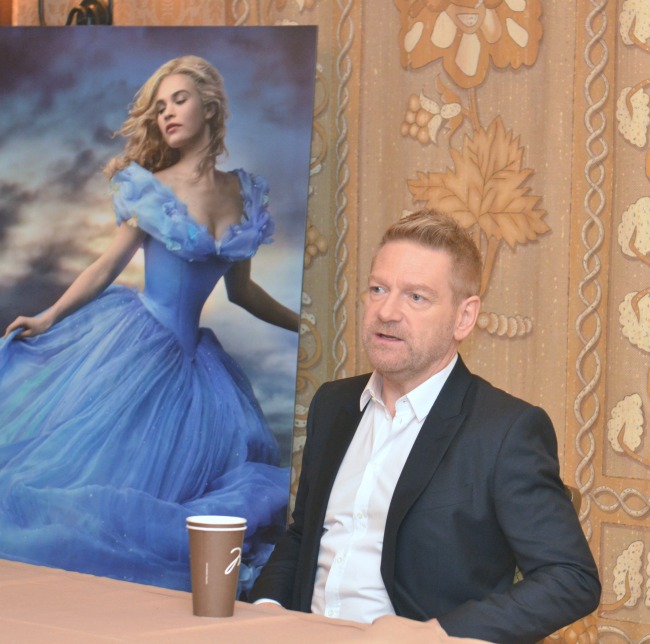 Photo Credit: Jana Seitzer of MerlotMommy.com
Photo Credit: Jana Seitzer of MerlotMommy.com
Kenneth Branagh Cinderella Interview | Hammers to Glass Slippers #CinderellaEvent
What do Thor Hammers and Cinderella Glass Slippers have in common? One heck of a resume.
Kenneth Branagh, the director that has swept the Marvel universe is now creating your child’s Disney princess dreams . Today, I’m getting into the “heavy” with my exclusive Kenneth Branagh Cinderella Interview. Everything you wanted to know from why he chose to direct this movie, his own Cinderella childhood memories, picking the perfect cast and even the story within the story, I have to say that this is one of my most memorable interviews to date. See how Kenneth Branagh brings out the feminine side in us all.
I was enraptured as soon as he entered the room. The doors open and as he is walking to his seat, he’s already talking. Ironically, Sir Kenneth Branagh came into the interview and was immediately “directing” the conversation.
“How is everybody this morning? Good. Who have you spoken to so far? Everyone? Oh, really. So I’m the last one in. All right.”
Fitting 🙂 And certainly I didn’t have a problem with that. A “sir.” A gentlemen, a lovely accent, and hey, not bad to look at either, this man captivated and held crowds just fine. You could tell that he was born to lead, to envision, to dream. Even the quotes I’ve highlighted from the interview are thoughtful and profound. And I discovered myself at the edge of my chair, clinging to his words. Right away I could tell, he got it.
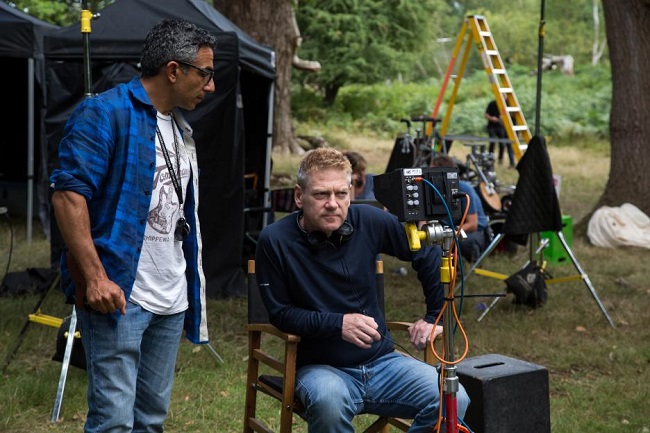
What brought you to this project?
“I think it was the surprise of being asked. I hadn’t long ago done Thor. And I did a film called Jack Ryan. And so a couple of quite boy-sy films. And being asked to do a girl’s film, if that’s not a stupid way of putting it and a fairytale and such a famous one…And I remembered a of couple things from Cinderella.
I loved the chase back from the palace at midnight. I really remember in the original animated film the stepmother coming out of the dark with two blazing green eyes at which she’s lying in bed. Cinderella brings her some tea. So I remember it being a bit scary, but very exciting and fun. I was very aware also if you do a Disney film then you have a big responsibility. There’s gonna be a lot of kids seeing it for the first time. And they all know the story as well. I’ve never made a film where the lights go down and you realize that everybody from five to 95 knows what’s gonna happen next.”
So it’s not about what happens next. It’s about how you do what happens next. So that was very exciting.
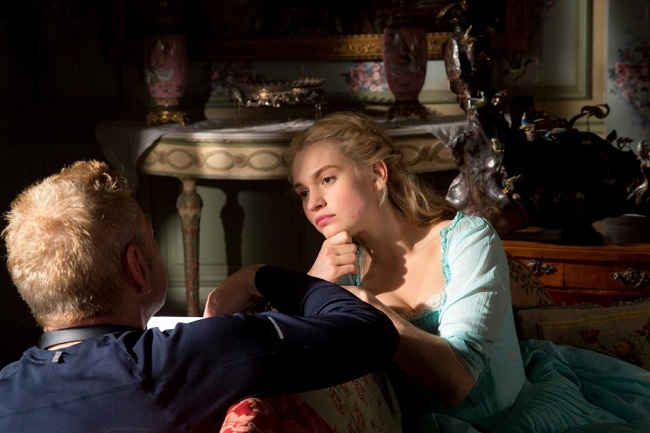
Casting the Perfect Cinderella
“I had an idea of how Cinderella should be. But in my experience, it was gonna be like I made a film, Thor, which took a long time to find the beautiful and sexy Chris Hemsworth, now officially the sexiest man in the world. So I thought, well, I have good taste then clearly. We knew that it would take a while and that you had to really feel the character– the actor would, in this case, you just want to be with them.
You want to be in their company. Yeah, she had to be likeable. You needed to want to spend those 90 minutes or whatever with her. And because of the way we were slightly re-imagining the character’s personality, she needed to have a good sense of humor, a kinda what we were calling a kind of an approachable beauty, and kindness and passion and strength and that could stand up in a scene with Miss Blanchett or Miss Bonham-Carter. And who also just had a kind of sort of simplicity without being, you know, sappy. [She] had to tick a lot of boxes.
So it was gonna take a long time. And I heard Lily James’ voice first. I thought, God, that’s a beautiful voice. And then she was a beautiful girl. And then she was very patient across a lot of auditions and things. And eventually it just became clear that she was the one.”
What about Richard Madden?
I thought that he had, apart from very blue eyes, he had [LAUGHTER] very tight trousers.
SCREECH? Did the nobleman just say tight trousers? There were about 20+ mouths that dropped open at that quote. I wasn’t sure whether to laugh or ignore. Thankfully, Kenneth Branagh quickly moved right into the next sentence.
“He had intelligence and wit. And also he relished the idea of how you might sort of play a gentleman. He wasn’t striving hard to be a certain modern kind of cool. You know, I think both these actors, I love the idea that they were prepared to be uncynical in the film, and just sort of respond directly to each other and that a gallantry, a courtship. The desire to woo, to serve, to listen were things that he felt could be played very positively and would be very, very attractive and that in a way there was a natural disposition in the world of the piece that we presented for him to love her. You know, and that he was able to do that and not see that as suddenly rendering him the love interest. It was a very powerful thing to be somebody listening, looking, and reacting with the screen time that he has, and I think it’s very touching and wonderful chemistry between them. And I think he was somebody I felt could do this thing we needed to do of having a man who earned Cinderella’s respect and love. [He] didn’t just get it because he had a big car.”

What was the most difficult scene to direct?
“I think probably the ballroom sequence because you knew that there would be so much expectation on it. And you knew that practically speaking you were gonna have 500 people, half of whom were gonna be in corsets. And that was gonna be a bit tricky. You know, you’ve gonna have 500 people to the loo as well during the course of the day. And then get them back on set before wasting too much time. And I knew that the dancing and then the sort of staging and the sense of our opulent it was and getting a sense of the glamour and the flamboyance of it was important. I wanted to take people to the ball. But I also knew that for me the scene was just as much about his hand on the small of her back in the beginning of that dance. So it was trying to keep that big large-scale ambitions with just wanting the human dynamic of the boy meets girl moment.”
A Classic Story Retold – From a Different Perspective
“For me, that’s what Chris Weitz’s screenplay had, and that’s what I liked. I remember saying to Ali Shearmur, our producer, at the beginning of the process, I said I think my big idea here is to try to get out of the way. The story’s been working for two and a half thousand years. There’s a reason why that’s happening. And my experience has been to try and let the work of great storytellers do as much work as possible and then try and amend and adjust as best you see fit from your own perspective. My experience, for instance, in Shakespeare and I’ve done it a number of times, where you take a strong conceptual idea and you might move the story completely. You might make it very modern. I did a version of a play called Love’s Labour’s Lost as a kind of Hollywood musical. So it shifted it by, you know, 300– 350 years and to some extent did tell it from a different kind of viewpoint. And I think a lot of people– they may not [have] just liked the film, but for a lot of people the actual idea itself was confusing. It got in the way and felt reductive. It may have been just specific to that. But I have found– I certainly, you know, I know that they in developing this they thought about whether she could be, in modern, wherever it might be, Brooklyn or whatever and indeed there’s tons of evidence of modern Cinderella stories, where gender is changed or time is changed. But I feel as though you get a chance to consider, provoke, and think differently if it’s through a classical perspective. To give a specific example, in doing it this way, in putting Cinderella and the prince on horseback, even Stevens, the same level, in a– in nature, in this ancient forest I think kind of cleans it up. So I get to see more of the two of them. I get a sense of the feeling in the scene in this sort of primal relationship there than I might do even if I came up with the most fantastic and brilliant, modern touches by having them meet in a restaurant or go on a bridge or on an airplane. All of which would be entirely legit as well. You could have– because the story’s so flexible. It’s just that I’m not as drawn to that myself. But I know– I’m sure as Disney and other people pursue the idea of of live action versions of fairy tales that that’s an absolute, open and regular invitation to see whether it can live that way.”
The world the Cinderella story is as much part of our culture as the actual telling of the real tale.
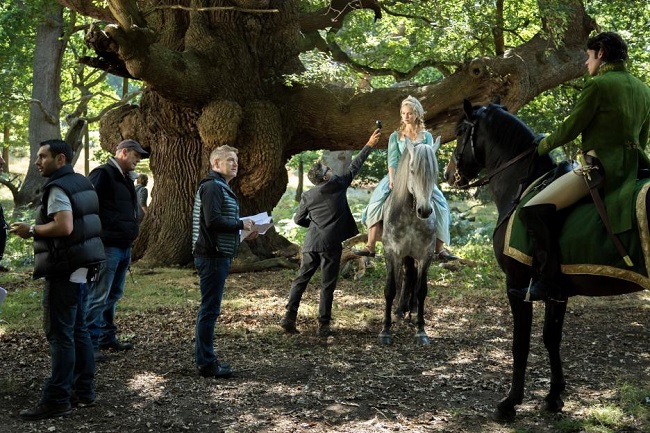
How did you chose the locations?
“We almost always have a location manager to whom you give a brief. And then they go off and help out. But being a small country, frankly, you end up knowing a few. And how I’ve done a few pictures with palaces in, I have my contacts as it were. But essentially of course we built so much of it that we didn’t do too much inside real palaces. So the whole of that ballroom is an entire construction on the 007 stage in Pinewood. But the outside of Cinderella’s house was all built for real in a place called Black Park. And then interestingly the forest where the prince and Cinderella [dance] is in Windsor Great Park, which is essentially the Queen’s back garden. She lives in Windsor Castle part of the time, so part of that park involves that group of oak trees which are over 600 years old. So it was very nice to be able to say to Lily and Richard you’re gonna do this magical scene in a magical place. ‘Cause these oak trees were here when Shakespeare was alive. So that was really very sort of magical.”
The Story within the Story
“You know what we did? It sounds a bit daft. But we scripted the entire mice story through the movie. So Chris Weitz and I sat down, and we wrote words, dialogue for all four of the mice in every scene in which they appeared. And then we recorded them with actors a couple of different ways. Sometimes we made the actors say it very, very, very slowly so that when we then speeded it up to be in sort of mice squeak mode, you could just get a half a hint, half a hint of what they were saying. So for instance Gus Gus at the end when he finally is persuaded that he shouldn’t eat the cheese and maybe he should jump on the back of the other three so they can open the window and they can hear Cinderella singing. He does something… There were a few little throw away remarks like that. I don’t think– although sometimes you do stuff unconsciously. I don’t think that we went back and raided mice remarks from the original movie. But there is a secret mouse play and screenplay inside the movie.”
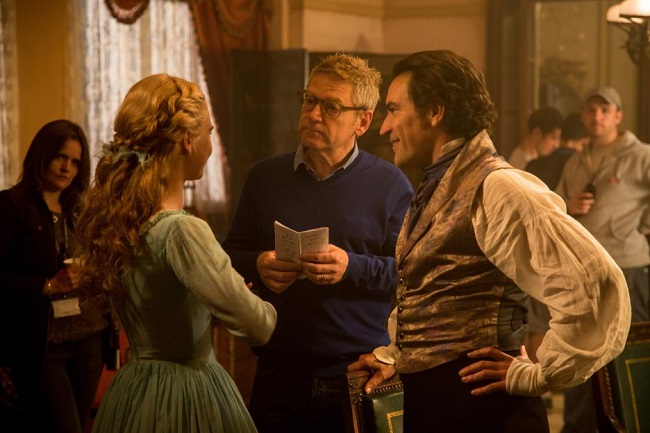
The Tough Decisions: Modern vs. Classic
“It’d be interesting now if you go back and look at the 1950 animated picture ’cause you may be surprised at how far we depart in a strange way. I think we absolutely embrace the spirit of it. And in a couple of occasions we really sort of hint at a couple of shots. But I think the real reinvention is the character of Cinderella and her kind of proactiveness. She doesn’t just wait around but also this uncynical belief in the power of kindness and courage. And one of the things we really wanted to do was just make sure that was not something that the kids were being sort of lectured with. It was done lightly enough from a character who seemed to embody it in a way that still allowed her to be happy and free and intelligent and smart and to be fun. I mean not suddenly be all self-righteous and pious and everything. So I think that that was something we tried very hard to do. And the hardest, hardest, hardest decision in the whole movie was– I know it’s a bit of a Disney cliché ’cause they’ve been doing it since Bambi, was losing parents. As you will have spotted, we got three out of four of the parents of [the movie] — just like, you know, so I feel responsible for a kind of attack on the grown ups. And it’s tough. You know, I mean it’s tough. But it’s beautiful. It’s beautiful. In the first ten minutes where Mum goes, my God, you see the shoulders heave. If you sit at the back of the auditorium and you see a lot of arms go around small people, either reach up or vice versa. And by the time the son loses dad the three-quarters of the way through the movie, that’s when you see the boys and the [dads] doing that as well. So we didn’t want to traumatize young people. But at the same time as I was mentioning earlier, you know, this sort of responsibility you have if you get the privilege of making a Disney movie is there is a way to maybe just find a compassionate way to talk about things that includes some of the difficult things that life throws up. As long as it can be done lightly and there’s lots of entertainment and everything else.”
What was your favorite iconic image?
“Well, all of those. But I felt very, secure in the world of Sandy Powell and her amazing talent with the costumes. And the determination to be very inventive about all of those things. So the kind of balance between finding this sort of classical approach.For instance, it sounds like a sort of a simplistic question, but there was a big question about what color is that dress? You know, does it stay blue? The original was blue. What kind of blue? Is it pink? Because the mother’s dress is pink. But should it stay pink in order to honor her mother? How much do we want to see a pink dress for that amount of time in the ballroom sequence? And what can we do with material? How magical can we make the material that is pink as opposed to blue or some other color? So those conversations were all had. But it just becomes a stage-by-stage kind of process. And you felt quite a pressure with the slippers because, you know, you’ve got ruby slippers. And you got other slippers in film history. And it was gonna be a big moment. So Sandy’s work with Swarovski to find this kind of multi-faceted thing, which also has a heaviness. It was incredibly heavy, the real thing, and a multi-faceted thing, I think was really a stroke of genius. And when we saw it for the first time it was very gasp inducing when we saw the actual object on a plinth that she presented it on. So I guess we took a long time to look at the big expectation moments. And I guess Cinderella at the top of the stairs coming into the ball was a favorite moment of mine. Or actually even just walking from the coach up the steps and into the palace I think the sort of moment where she comes into her own.”
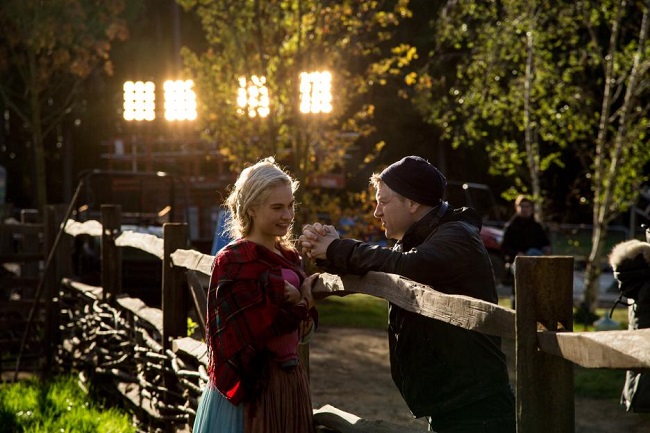
Creating a New Disney Princess Image
“Well, I think that we start with her in a family that’s functioning and loving and supportive and, in a sense you see it created inasmuch she’s brought in to the death of the mother. So that’s shared with her. And I think the passing on of a kind of a generous outlook I think is important. We also see that when faced with, perhaps the latest extreme example of cruelty, which is the renaming of her, we see a moment where she gets on that horse and she goes. I think a question anybody asks of a modern Cinderella, why doesn’t she leave? Well, she may leave there. And she certainly has a passionate response to it and a passionate response to the prince that she encounters. But as she talks about later on, she stays there partly ’cause she– in her view at this point, she honors her mother and father. And that’s a positive and proactive decision I think to stay there. We see a house that’s full of curiosity. There are curious minds at work. So I think she stays partly to try and understand it. I would say that’s an example of proactivity. And by the time she talks to the stepmother and stays, I mean the proactivity is the decision to stay in a way and say ‘Why? Why are you so cruel?’ A determination to ask it and understand this. Rather than simply react against it. The script was slightly different, how and when and under what circumstances might she leave? And I think we found interesting alternates to that. But the challenge was to try and keep her there and keep her in the story but somehow find the way to express a strength that made us believe as we did going into it that this was a Cinderella who ultimately we believed would be fine if a prince didn’t come along who was not searching for that. But what’s searching on one level was searching for how you can be happy, and in this case how you can be happy once what was your happiness, your happy family has been removed? So I think in those ways, I think that’s how we go at it.”
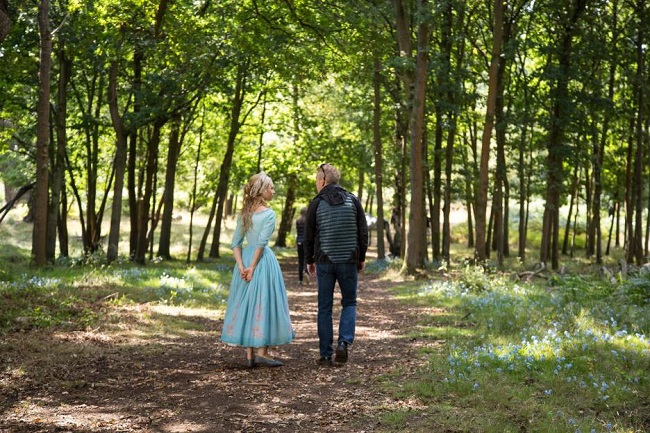
Why Cinderella?
“I mean it specifically came my way. For me, the surprise was being asked to do this specific one. Partly I think people feel an incredible ownership of the story. I think it’s very personal to a lot of people. I think that there’s a relationship to the underdog or the outsider or however we chose to categorize her that seems to represent us, our hopes and dreams and aspirations. And there was a chance to do that but sort of recalibrate them. So in the scene between the sisters and Cinderella, Cinderella says, ‘What about the prince? What do you think he’ll be like?’ And they said doesn’t matter what he’s like. He’s a prince. And, anyway, all men are stupid. The idea of working out whether it’s possible to present the Cinderella who may feel differently about that was I think important to break some of those kind of types. But I think that in my experience, even just making that ball scene across– we had hundreds of extras. And we had hundreds of crew people and lots of people who had sort of been there and done that, were very jaded in the film business perhaps you might say who were extremely moved by this image of somebody who gets their shot, who gets a chance to be happy, who gets their trip to the ball, whether that’s literal or an image. And so I think to be involved in something as important to people, as symbolically important to people, as simple as it appears to be, was very enticing.”
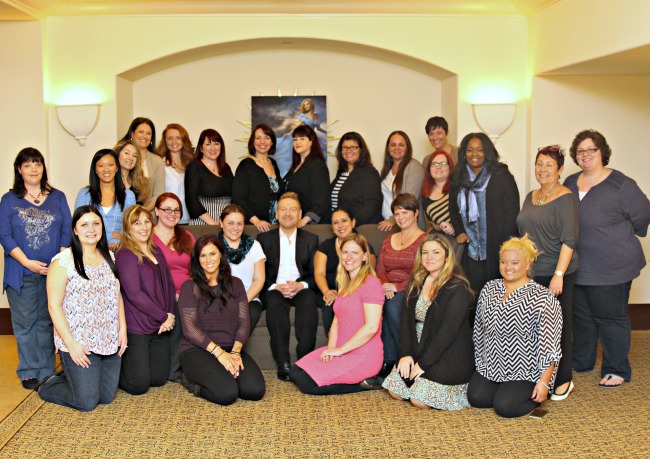 Photo Credit: Disney
Photo Credit: Disney
I think the biggest take away I had from this interview was that Kenneth Branagh was certainly not wanting to break any headlines or use any crazy effects to get the word out about this movie. It’s taking something that has worked for thousands of years and just weaving in his own personal story with it. And I think it’s in his restraint and retaining that purity is just as hard of a decision as is the planning of the next greatest explosion. It’s in the simplicity, the innocence and the magic of Cinderella that we all find a piece of ourselves in that story that can be shared again and again. Cinderella is the magic within all of us. Kenneth Branagh just reminded us how real it can be.
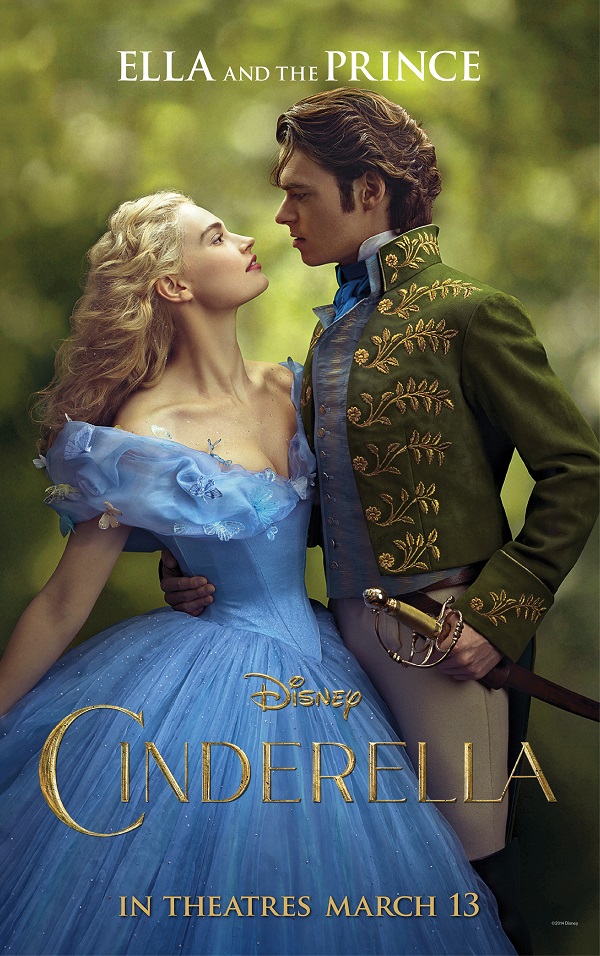
Cinderella, in theaters March 13, 2015. See the beauty of the fairy tale story come to life.
Have you been following along my #CinderellaEvent journey? Check out my own Cinderella Moments at the JCPenney Glam Ball and My First Red Carpet Experience. Stay tuned for more amazing of my Disney Cinderella interviews with Richard Madden (The Prince), Director Kenneth Branagh, Costume Designer Sandy Powell, and Frozen Fever Directors Chris Buck and Jennifer Lee.
- Check out my exclusive Cate Blanchett interview (Lady Tremaine) as we discuss what makes a Wicked Stepmother.
- Check out my exclusive Lily James interview (Cinderella) as we find out what makes a Disney Princess come to life.
- Check out my exclusive Frozen Fever interview as we get a behind the scenes peek with Directors Chris Buck & Jennifer Lee.
What do you think of Kenneth Branagh’s vision for the live-action Cinderella story?
Disclosure ~ I received an all-inclusive Disney media trip in exchange for this posting. All opinions are my own. Be sure to follow Saving Said Simply for more reviews, giveaways and more.






Rosey says
The costumes really are amazing, I can see why he had confidence in the designer. And I laughed about the tight trousers…maybe he was referring to skinny jeans, lol (those do look painted on). 🙂 This was a fun/great interview to do! I like the group blog picture too.